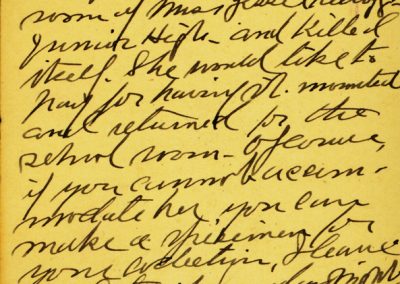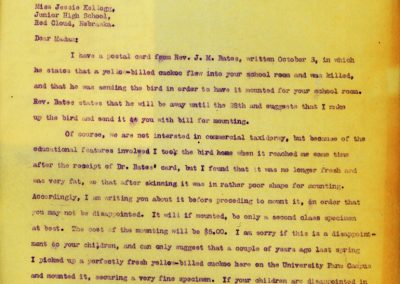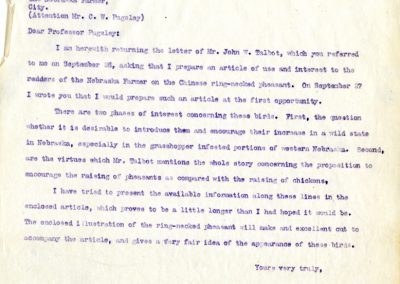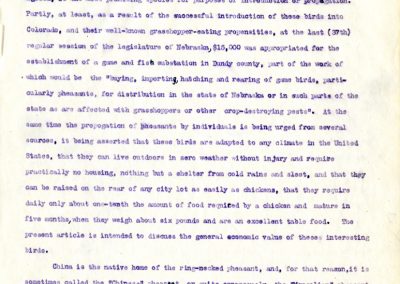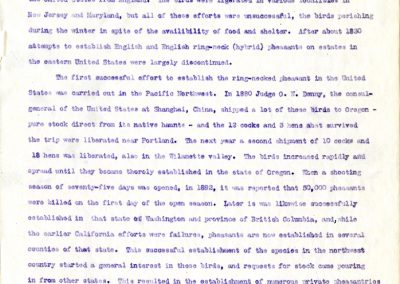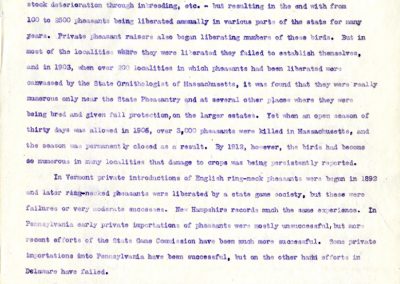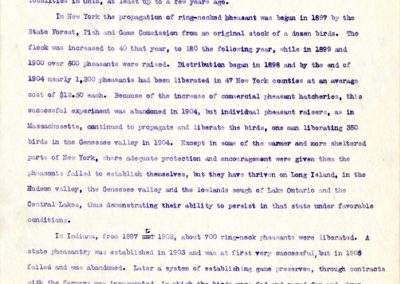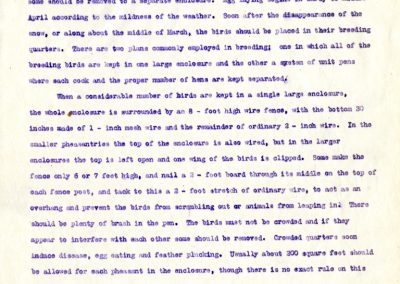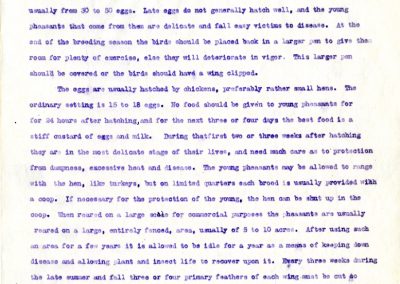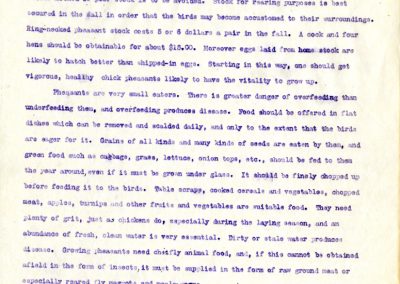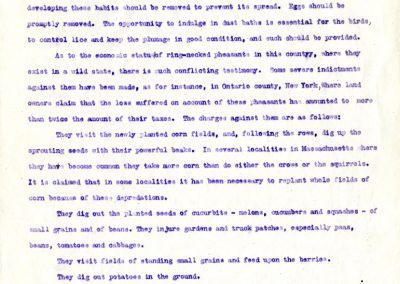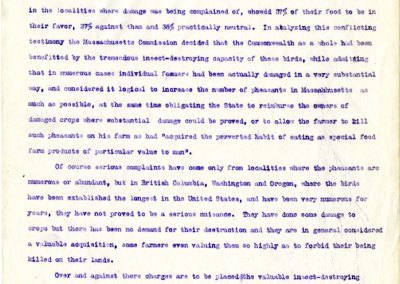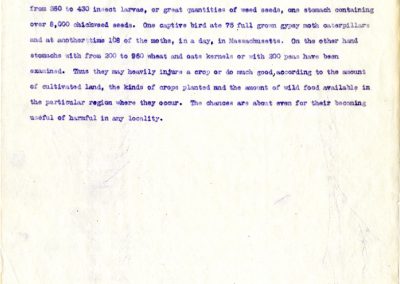Great Nebraska
Naturalists and ScientistsNebraska Ornithologists’ Union
Letters, 1919, October
1919, Oct. 3
Red Cloud, Neb. Oct. 3, 1919.
Dear Prof. Luenk, I send you a perfect yellowbill cuckoo that flew into the school room of Miss Jessie Kellogg, Junior High, and killed itself. She would like to pay for having it mounted and returned to the school room. Of course if you cannot accommodate her, you can make a specimen for your collection. I leave for Detroit Sunday night till the 28th but you may send it to her if you make it [illegible] with the bill or wait till I return. Sinerely yours, J.M. Bates.
1919, Oct. 11
October 11, 1919.
Miss Jessie Kellogg, Junior High School, Red Cloud, Nebraska.
Dear Madam: I have a postal card from Rev. J. M. Bates, written October 3, in which he states that a yellow-billed cuckoo flew into your school room and was killed, and that he was sending the bird in order to have it mounted for your school room. Rev. Bates states that he will be away until the 28th and suggests that I make up the bird and send it to you with bill for mounting.
Of course, we are not interested in commercial taxidermy, but because of the educational features involved I took the bird home when it reached me some time after the receipt of Dr. Bates’ card, but I found that it was no longer fresh and was very fat, so that after skinning it was in rather poor shape for mounting. Accordingly, I am writing you about it before proceding to mount it, in order that you may not be disappointed. It will if mounted, be only a second class specimen at best. The cost of mounting will be $5.00. I am sorry if this is a disappointment to your children, and can only suggest that a couple of years ago last spring I picked up a perfectly fresh yellow-billed cuckoo here on the University Farm Campus and mounted it, securing a very fine specimen. If your children are disappointed in not being able to get a really nice specimen from their bird, and if they do not object to the substitution, I will send them the above mentioned specimen for the mounting charges. Please let me know your pleasure in this matter, as I will do nothing further either way until I hear from you. Yours very truly,
1919, Oct. 30
October 30, 1919.
The Nebraska Farmer, City. (Attention Mr. C. W. Pugsley)
Dear Professor Pugsley: I am herewith returning the letter of Mr. John W. Talbot, which you referred to me on September 26, asking that I prepare an article of use and interest to the readers of the Nebraska Farmer on the Chinese ring-necked pheasant. On September 27 I wrote you that I would prepare such an article at the first opportunity. There are two phases of interest concerning these birds. First, the question whether it is desirable to introduce them and encourage their increase in a wild state in Nebraska, especially in the grasshopper infested portions of western Nebraska. Second. are the virtues which Mr. Talbot mentions the whole story concerning the proposition to encourage the raising of pheasants as compared with the raising of chickens. I have tried to present the available information along these lines in the enclosed article, which proves to be a little longer than I had hoped it would be. The enclosed illustration of the ring-necked pheasant will make and excellent cut to accompany the article, and gives a very fair idea of the appearance of these birds. Yours very truly,
1919, Myron Swenk, Article
THE ECONOMIC VALUE OF THE RING-NECKED PHEASANT.
At the present time there is some interest being manifested on the part of the farmers of Nebraska as to the utilitarian value of imported pheasants, and particularly of the species known as the ring-necked pheasant, which, it is generally agreed, is the most promising species for purposes of introduction or propagation. Partly, at least, as a result of the successful introduction of these birds into Colorado, and their well-known grasshopper-eating propensities, at the last (37th) regular session of the legislature of Nebraska, $15,000 was appropriated for the establishment of a game and fish substation in Dundy county, part of the work of which would be the “buying, importing, hatching and rearing of game birds, particularly pheasants, for distribution in the state of Nebraska or in such parts of the state as are affected with grasshoppers or other crop-destroying pests”. At the same time the propagation of pheasants by individuals is being urged from several sources, it being asserted that these birds are adapted to any climate in the United States, that they can live outdoors in zero weather without injury and require practically no housing, nothing but a shelter from cold rains and sleet, and that they can be raised on the rear of any city lot as easily as chickens, that they require daily only about one-tenth the amount of food required by a chicken and mature in five months, when they weigh about six pounds and are an excellent table food. The present article is intended to discuss the general economic value of these interesting birds.
China is the native home of the ring-necked pheasant, and, for that reason, it is sometimes called the “Chinese” pheasant, or quite erroneously, the “Mongolian” pheasant, which is an entirely different bird. It, and its close relative the so-called English pheasant, have been the object of many attempts, both successful and the opposite, at introduction into new countries. The latter species was brought from western Asia by the Greeks at about the time of Alexander the Great, and introduced into England by the Romans before the Norman Conquest. The earliest recorded successful introduction of
The first successful effort to establish the ring-necked pheasant in the United States was carried out in the Pacific Northwest. In 1880 Judge O. N. Denny, the consul-general of the United States at Shanghai, China, shipped a lot of these birds to Oregon – pure stock direct from its native haunts – and the 12 cocks and 3 hens ahat survived the trip were liberated near Portland. The next year a second shipment of 10 cocks and 18 hens was liberated, also in the Wilamette valley. The birds increased rapidly and spread until they became thoroly established in the state of Oregon. When a shooting season of seventy-five days was opened, in 1892, it was reported that 50,000 pheasants were killed on the first day of the open season. Later is was likewise successfully established in that state of Washington and province of British Columbia, and, while the earlier California efforts were failures, pheasants are now established in several counties of that state. This successful establishment of the species in the northwest country started a general interest in these birds, and requests for stock came pouring in from other states. This resulted in the establishment of numerous private pheasantries in Oregon, and in 1899 shipments were made to 22 states, representing every section of our nation. But, because of the unsuitability of many of the localities, and also to improper methods of handling, most of these early efforts at further establishment of the bird failed.
In Vermont private introductions of English ring-neck pheasants were begun in 1892 and later ring-necked pheasants were liberated by a state game society, but these were failures or very moderate successes. New Hampshire records much the same experience. In Pennsylvania early private importations of pheasants were mostly unsuccessful, but more recent efforts of the State Game Commission have been much more successful. Some private importations into Pennsylvania have been successful, but on the other hand efforts in Delaware have failed.
In the same year that Massachusetts began its pheasant rearing experiments, the state of Ohio also began efforts to propagate these birds. At first the efforts were very successful, and the birds were liberated in numbers. In 1900, 2, 239 pheasants were distributed over the state, some being placed in every county. In 1901, 1,688
In New York the propagation of ring-necked pheasant was begun in 1897 by the State Forest, Fish and Game Commission from an original stock of a dozen birds. The flock was increased to 40 that year, to 180 the following year, while in 1899 and 1900 over 600 pheasants were raised. Distribution began in 1898 and by the end of 1904 nearly 1,200 pheasants had been liberated in 47 New York counties at an average cost of $12.50 each. Because of the increase of commercial pheasant hatcheries, this successful experiment was abandoned in 1904, but individual pheasant raisers, as in Massachusetts, continued to propagate and liberate the birds, one man liberating 350 birds in the Genessee valley in 1904. Except in some of the warmer and more sheltered parts of New York, where adequate protection and encouragement were given them the pheasants failed to establish themselves, but they have thriven on Long Island, in the Hudson valley, the Genessee valley and the lowlands sough of Lake Ontario and the Central Lakes, thus demonstrating their ability to persist in that state under favorable conditions.
In Indiana, from 1897 to 1902, about 700 ring-neck pheasants were liberated. A state pheasantry was established in 1903 and was at first very successful, but in 1905 failed and was abandoned. Later a system of establishing game preserves, through contracts with the farmers was inaugurated, in which the birds were fed and cared for and given protection from shooting for four years after stocking, but in which they are allowed to propagate naturally. This method has proved more successful, and is popular with both farmers and sportsmen, and in 1910 the number of pheasants in Indiana was estimated at several thousand.
The ring-necked pheasant is a hardy bird, and can withstand as much cold weather and snow as any of our domesticated gallinaceous fowls. In fact, unless the weather is very severe, they neglect the coops and prefer to roost in the exposed parts of fields. They have safely gone through winter weather as cold as 45 degrees below zero, and are so little discomfited by snow that they remain buried under heavy snows for days, digging burrows in it and feeding on the grass or other vegetation which they find under the snow. But such great exposure does not promote the greatest thriftiness in the birds, and it is much better to provide a reasonable amount of shelter for them to use in very severe weather and to clear out a space in teh enclosures so that the birds may emerge from the snow and freely feed. They should always be protected from exposure to excessive dampness.
As to the domesticity and ease of rearing pheasants, considerable must be said to give a full understanding of the problem. They are not as easily reared as chickens, as they do not stand close confinement as well and are more susceptible to diseases. In fact, the ring-necked pheasant is probably not the best species of pheasant to propagate if the birds must be reared in close confinement, as for instance on the back of a city lot, for it should have a more or less open rage for its young to do well.
When a considerable number of birds are kept in a single large enclosure, the whole enclosure is surrounded by an 8 – foot high wire fence, with the bottom 30 inches made of 1 – inch mesh wire and the remainder of ordinary 2 – inch wire. In the smaller pheasantries the top of the enclosure is also wired, but in the larger enclosures the top is left open and one wing of the birds is clipped. Some make the fence only 6 or 7 feet high, and nail a 2 – foot board through its middle on the top of each fence post, and tack to this a 2 – feet stretch of ordinary wire, to act as an overhang and prevent the birds from scrambling out or animals from leaping in. There should be plenty of brush in the pen. The birds must not be crowded and if they appear to interfere with each other some should be removed. Crowded quarters soon induce disease, egg eating and feather plucking. Usually about 200 square feet should be allowed for each pheasant in the enclosure, though there is no exact rule on this point.
If separate pens are maintained, these are made to be portable, about 12 x 16 feet, without bottoms, screened on top and boarded up from the ground about 3 feet, with the bottom boards of the longer sides arranged like sled runners so that the pen can be dragged to a new location when desired. At one end inside there is a 3-foot
The number of eggs produced by a hen ring-necked pheasant varies according to the vigor of the bird, its feeding and environment, from 30 to 100 in a season, usually from 30 to 50 eggs. Late eggs do not generally hatch well, and the young pheasants that come from them are delicate and fall easy victims to disease. At the end of the breeding season the birds should be placed back in a larger pen to give them room for plenty of exercise, else they will deteriorate in vigor. This larger pen should be covered or the birds should have a wing clipped.
The eggs are usually hatched by chickens, preferably rather small hens. The ordinary setting is 15 to 18 eggs. No food shold be given to young pheasants for for 24 hours after hatching, and for the next three or four days the best food is a stiff custard of eggs and milk. During that first two or three weeks after hatching they are in the most delicate stage of their lives, and need much care as to protection from dampness, excessive heat and disease. The young pheasants may be allowed to range with the hen, like turkeys, but on limited quarters each brood is usually provided with a coop. If necessary for the protection of the young, the hen can be shut up in the coop. When reared on a large scale for commercial purposes the pheasants are usually reared on a large, entirely fenced, area, usually of 5 to 10 acres. After using such an area for a few years it is allowed to be idle for a year as a means of keeping down disease and allowing plant and insect life to recover upon it. Every three weeks during the late summer and fall three or four primary feathers of each wing must be cut to keep the birds in the enclosure. The young pheasants are removed when about five weeks old, with about one hen to thirty young pheasants, to fresh pens with plenty of grass and insects. Later the hens are removed. If any batch does poorly it is promptly removed to another pen. When reared on a large scale for purposes of distribution for stocking as game-birds, the hen and young are usually allowed free range all over the place. The birds return at night to feed, even when they have left the hens and range
A start in raising pheasants may be made either by buying eggs or birds. Eggs for hatching cost about $3.00 a dozen, and early eggs (April and May) are far better than late ones. As one can actually see the stock when birds are purchased, this is the better method if poor stock is to be avoided. Stock for rearing purposes is best secured in the fall in order that the birds may become accustomed to their surroundings. Ring-necked pheasant stock costs 5 or 6 dollars a pair in the fall. A cock and four hens should be obtainable for about $15.00. Moreover eggs laid from home stock are likely to hatch better than shipped-in eggs. Starting in this way, one should get vigorous, healthy chick pheasants likely to have the vitality to grow up.
Pheasants are very small eaters. There is greater danger of overfeeding than underfeeding them, and overfeeding produces disease. Food should be offered in flat dishes which can be removed and scalded daily, and only to the extent that the birds are eager for it. Grains of all kinds and many kinds of seeds are eaten by them, and green food such as cabbage, grass, lettuce, onion tops, etc., should be fed to them the year around, even if it must be grown under glass. It should be finely chopped up before feeding it to the birds. Table scraps, cooked cereals and vegetables, chopped meat, apples, turnips and other fruits and vegetables are suitable food. They need plenty of grit just as chickens do, especially during the laying season, and an abundance of fresh, clean water is very essential. Dirty or stale water produces disease. Growing pheasants need chiefly animal food, and, if this cannot be obtained afield in the form of insects, it must be supplied in the form of raw ground meat or especially reared fly maggots and meal-worms.
The one difficult thing in rearing pheasants, seven the hardy ring-necks, is to avoid diseases, especially epidemic diseases. They are much more susceptible to these troubles than are chickens. Young pheasants, especially, are prone to disease. During their first week they have a tendency to pasting of the vent and whitish diarrhea,
As to the economic status of ring-necked pheasants in this country, where they exist in a wild state, there is much conflicting testimony. Some severe indictments against them have been made, as for instance, in Ontario county, New York, where land owners claim that the loss suffered on account of these pheasants has amounted to more than twice the amount of their taxes. The charges against them are as follows:
They visit the newly planted corn fields, and, following the rows, dig up the sprouting seeds with their powerful beaks. In several localities in Massachusetts where they have become common they take more corn than do either the crows or the squirrels. It is claimed that in some localities it has been necessary to replant whole fields of corn because of these depredations. They dig out the planted seeds of cucurbits – melons, cucumbers, and squashes – small grains and of beans. They injure gardens and truck patches, especially peas, beans, tomatoes and cabbage. They visit fields of standing small grains and feed upon the berries. They dig out potatoes in the ground. They drive away and kill native game birds, such as Bobwhites and grouse. They drive chickens away from their feed and even kill young poultry.
In 1914 the Massachusetts Commission reported that during 1912 and 1913 numerous complaints had been made to it of damage to farm crops by wild pheasants. Of 44 formal complaints lodged in that office in those years, 21 related to damage to corn,
Of course serious complaints have come only from localities where the pheasants are numerous or abundant, but in British Columbia, Washington and Oregon, where the birds have been established the longest in the United States, and have been very numerous for years, they have not proved to be a serious nuisance. They have done some damage to crops but there has been no demand for their destruction and they are in general considered a valuable acquisition, some farmers even valuing them so highly as to forbid their being killed on their lands.
Over and against there charges are to be placed the valuable insect-destroying habits of these birds. They are very fond of grasshoppers, and consume large quantities of them. They also eat many injurious caterpillars and beetles, and destroy many weed seeds, such as the seeds of dandelion, lupine, bar clover, black mustard and chickweed. During the fall months about one-third of the food is wheat and oats, probably largely waste grain. Acorns and pine nuts are much eaten when securable, stomachs examined by
Because of the evident fact that these ring-necked pheasants feed rather heavily on such food as is available, their capabilities for good or harm are great. They may destroy great numbers of grasshoppers or other insects, stomachs sometimes containing from 360 to 430 insect larvae, or great quantities of weed seeds, one stomach containing over 8,000 chickweed seeds. One captive bird ate 75 full grown gypsy moth caterpillars and at another time 108 of the moths, in a day, in Massachusetts. On the other hand stomachs with from 200 to 960 wheat and oats kernels or with 200 peas have been examined. Thus they may heavily injure a crop or do much good, according to the amount of cultivated land, the kinds of crops planted and the amount of wild food available in the particular region where they occur. The chances are about even for their becoming useful of harmful in any locality.
